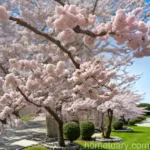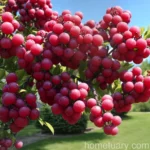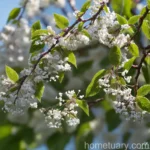The Fascinating World of Cherry Plum (Prunus cerasifera)
Welcome to our latest blog post where we delve into the captivating world of the cherry plum (Prunus cerasifera). As a plant scientist, I am thrilled to share with you the key aspects of this beautiful and versatile plant. From its cultural significance to its unique uses and care tips, this article is your ultimate guide to understanding and growing the cherry plum.
What is Cherry Plum (Prunus cerasifera)?
Prunus cerasifera, commonly known as cherry plum, is a deciduous flowering tree belonging to the Rosaceae family. Originating from regions of Southeast Europe and Western Asia, this species has captured the interest of horticulturists and enthusiasts due to its ornamental value, fruit production, and adaptability to various climates.
Key Takeaways – Cherry Plum (Prunus cerasifera)
- Scientific Name: Prunus cerasifera
- Common Name: Cherry Plum
- Family: Rosaceae
- Origin: Southeast Europe and Western Asia
- Growth Habit: Deciduous tree
- Uses: Ornamental, fruit production
- Distinctive Feature: Small, edible fruits
Now, let’s explore the various facets of cherry plum, including its culture, uses, care requirements, common diseases, and interesting facts.
Culture
Cultivating cherry plum trees can be a rewarding experience, especially for those who appreciate the beauty of flowering trees and the bounty of fresh fruits. Understanding the cultivation requirements is essential for successfully growing and nurturing cherry plum trees.
Water
Cherry plum trees require regular watering, particularly during their initial growth stages and periods of drought. Adequate soil moisture is crucial for the development of healthy foliage and fruit production. However, it’s important to avoid waterlogged conditions that can lead to root rot.
Sunlight
Being native to regions with abundant sunlight, cherry plum trees thrive in full sun exposure. Therefore, when selecting a planting location, ensure that it receives ample sunlight throughout the day. This enables the tree to develop robust foliage and promotes the formation of flowers and fruits.
Fertilizer
To support optimal growth and fruiting, cherry plum trees benefit from regular fertilization. Choose a balanced fertilizer specifically formulated for fruit trees and apply it during the active growing season. Additionally, organic compost can be incorporated into the soil to enhance its nutrient content.
Soil
Cherry plum trees prefer well-draining soil with a slightly acidic to neutral pH. Loamy and sandy soils are suitable for their cultivation, provided they offer good drainage. Conducting a soil test can provide valuable insights into the soil’s composition and nutrient levels, guiding the appropriate amendments for optimal tree growth.
Pruning
Pruning is a crucial aspect of cherry plum tree care, contributing to its overall health, shape, and fruit production. Proper pruning techniques involve the removal of dead or diseased branches, shaping the tree for structural integrity, and promoting adequate air circulation within the canopy. It is advisable to perform pruning during the dormant season to minimize stress on the tree.
To encourage the development of flowers and fruits, it is essential to prune cherry plum trees judiciously. Early spring is an ideal time to carry out selective pruning, allowing the tree to channel its energy into new growth and blossoming.
Propagation
Cherry plum trees can be propagated through various methods, including seed germination, cutting propagation, and grafting. Each approach has its advantages and challenges, with some methods yielding quicker results than others. Select the propagation method that aligns with your resources, expertise, and specific goals for tree cultivation.
Container Popularity
Cherry plum trees are also favored for container cultivation, offering individuals with limited outdoor space the opportunity to enjoy their beauty and harvest homegrown fruits. When grown in containers, cherry plum trees require diligent care, particularly in terms of watering, fertilization, and adequate room for root development. Choosing a sizable container and employing proper drainage are essential for the tree’s well-being.
Common Diseases
Cherry plum trees may be susceptible to certain diseases, including:
- Brown Rot: A fungal disease that affects the fruit, causing it to rot and develop brown spots. Proper sanitation and fungicidal treatments can help manage this disease.
- Leaf Curl: Manifested by the curling and distortion of leaves, this condition can be a result of fungal infection or environmental stress. Implementing proper irrigation and maintaining good air circulation can aid in preventing leaf curl.
- Canker Diseases: Canker infections can lead to the development of sunken lesions on the tree’s bark, potentially causing dieback. Timely pruning of affected branches and promoting overall tree health are instrumental in managing canker diseases.
Disease Diagnosis
Diagnosing and addressing diseases in cherry plum trees requires keen observation and understanding of the symptoms associated with common infections. By conducting regular inspections of the tree’s foliage, fruits, and bark, early signs of diseases can be identified, allowing for prompt intervention. Seeking guidance from local agricultural extension services or certified arborists can provide valuable assistance in accurate disease diagnosis.
Common Pests
A few pests that can potentially affect cherry plum trees are:
- Aphids: These tiny insects feed on the sap of leaves and tender shoots, potentially causing distortion and stunted growth. Natural predators, such as ladybugs, can assist in controlling aphid populations.
- Plum Curculio: Known for damaging fruits by laying eggs within them, plum curculios can lead to significant crop losses if left unmanaged. Implementing preventive measures, such as trapping and insecticide applications, is crucial for curbing their impact.
- Spider Mites: These arachnids can infest cherry plum trees, causing stippling on leaves and a decrease in overall vigor. Regular monitoring and employing natural predators, such as predatory mites, can aid in controlling spider mite populations.
Botanist’s Tips
I would like to share some valuable tips for successfully cultivating and caring for cherry plum (Prunus cerasifera) trees:
- Regular Inspection: Routinely inspect the tree for signs of pests, diseases, and nutrient deficiencies to address any issues promptly.
- Proper Pruning: Adhere to proper pruning practices to maintain the tree’s structure, optimize fruit production, and promote overall health.
- Soil Health: Prioritize soil health by incorporating organic matter, monitoring pH levels, and ensuring adequate drainage.
Fun Facts
Did you know that cherry plum (Prunus cerasifera) has some remarkable traits and historical significance? Here are a few fun facts about this fascinating tree:
- The cherry plum is esteemed for its early blooming flowers, adorning landscapes with delicate blooms during the spring season.
- It is an excellent choice for wildlife-friendly gardens, attracting pollinators and contributing to biodiversity.
- Cherry plums have been used in traditional folk medicine for their purported health benefits, including their nutritional value and potential antioxidant properties.
Links to External Resources
To further enrich your knowledge about cherry plum (Prunus cerasifera) and its diverse aspects, I recommend exploring the following external resources:
- The Spruce – Growing Cherry Plum Trees
- Royal Horticultural Society – Prunus cerasifera
- University of California Agriculture and Natural Resources – Prunus cerasifera
As we conclude this comprehensive exploration of the captivating cherry plum (Prunus cerasifera), I hope you have gained a deeper appreciation for this remarkable species. Whether you seek to adorn your garden with its enchanting blooms or savor its delectable fruits, the cherry plum stands as a testament to the natural beauty and abundance found in the plant kingdom. Happy gardening!
Disclaimer: The information provided in this article is for educational and informational purposes and does not serve as professional horticultural or medical advice. Always consult with certified professionals for specific guidance regarding tree care and potential medicinal uses.
 This work is licensed under the Creative Commons Attribution 4.0 International License.
This work is licensed under the Creative Commons Attribution 4.0 International License.















